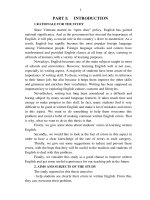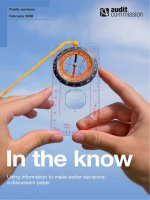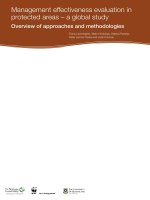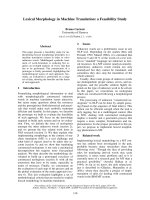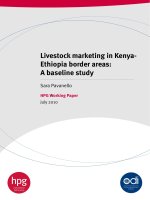Information Structure in written English - a corpus study - docx
Bạn đang xem bản rút gọn của tài liệu. Xem và tải ngay bản đầy đủ của tài liệu tại đây (74.52 KB, 44 trang )
Information Structure in written English
- a corpus study -
Oana Postolache
IGK colloquium – 8 Dec 05
2
p Division of the sentence in two parts:
1. Links the sentences to the discourse
2. Advances the discourse (brings new information)
Rob needs to talk things out, and he certainly isn’t going to do
that with Dick or Barry. So, he talks to HIMSELF instead.
Topic Focus Topic
p Not the given/new distinction
Information Structure (IS)
3
Thesis Goal
p Develop computational methods to automatically detect IS
for naturally occurring English sentences.
p Trial 1:
n Use the PDT to develop a system that detects Topic & Focus for
Czech.
n Use a parallel corpus to transfer Topic & Focus to English,
through word alignment (in order to create an English corpus).
p Trial 2: Investigation of English corpora.
4
Realization of IS in English
p Intonation
p Non-canonical word order
n Gregory Ward & Betty Birner studies:
p 1998 – Information Status and Non-canonical Word Order in English
p 2001 – Discourse and Information Structure
p 2004 – Information Structure and Non-canonical Syntax
n Distinguish 5 types of non-canonical constructions which impose
constraints on the IS of the sentence:
p preposing, left-dislocation, postposing, right-dislocation and inversion
n Their corpus consists in several thousands naturally occurring
sentences collected over approx. 10 years.
5
What is this talk about?
p Consider 2 corpora:
n WSJ – news (1,107,392 words)
n “1984” – belletristic (104,136 words)
p Investigate:
n How often these non-canonical constructions appear?
n Do they comply with Ward & Birner constraints?
n What is their Information Structure?
6
Outline
p Background
n Information Status (vs Information Structure)
n POSET relationship
n Focus / Open-proposition theory
p 5 non-canonical constructions
n Definition and exemplification
n Ward & Birner constraints
n Information Structure
n Occurrence in corpora
p Summary
7
Outline
p Background
n Information Status (vs Information Structure)
n POSET relationship
n Focus / Open-proposition theory
p 5 non-canonical constructions
n Definition and exemplification
n Ward & Birner constraints
n Information Structure
n Occurrence in corpora
p Summary
8
Information Status
Discourse new
Hearer old
Discourse new
Hearer new
Discourse old
Hearer old
Inferrable
Prince 1981, 1992
p Regards the discourse familiarity or the hearer familiarity of an
entity or event
n Discourse-new / Discourse-old
n Hearer-new / Hearer-old
n Inferrable
Last night the moon was so pretty that I called a friend
on the phone and told him to go outside and look.
9
Outline
p Background
n Information Status (vs Information Structure)
n POSET relationship
n Focus / Open-proposition theory
p 5 non-canonical constructions
n Definition and exemplification
n Ward & Birner constraints
n Information Structure
n Occurrence in corpora
p Summary
10
POSET relationship
Birner & Ward 1998
p Linking relations: identity, type/subtype, entity/attribute,
part/whole, etc.
p A POSET (Partially Ordered SET) is any set defined by a
transitive partial ordering linking relation.
– Do you like this album?
– Yeah, this song I really like.
Relation = is-part-of, POSET = {album parts}
– Have you filled out the Summary Sheet?
– Yes, both the Summary Sheet and the Recording Sheet I’ve done.
Relation = is-a-member-of, POSET = {forms}
– Did you get any more answers for the crossword puzzle?
– No, the cryptogram I can do like that; the crossword puzzle is hard.
Relation = is-type-of, POSET = {newspaper puzzles}
11
Outline
p Background
n Information Status (vs Information Structure)
n POSET relationship
n Focus / Open-proposition theory
p 5 non-canonical constructions
n Definition and exemplification
n Ward & Birner constraints
n Information Structure
n Occurrence in corpora
p Summary
12
Focus / Open-proposition theory
Prince 1981, 1984, 1986
p Open-proposition (OP): the information in the sentence that is
assumed by the writer to be shared by him and the reader.
p Focus: the complement of this presupposition.
I promised my father – on Christmas Eve it was – to kill a
Frenchman at the first opportunity.
OP = It was X, where X ∈ {times}
X = on Christmas Eve
p What constitutes new information is the fact that a particular
focus instantiates the variable in the open-proposition.
13
Outline
p Background
n Information Status (vs Information Structure)
n POSET relationship
n Focus / Open-proposition theory
p 5 non-canonical constructions
n Definition and exemplification
n Ward & Birner constraints
n Information Structure
n Occurrence in corpora
p Summary
14
Preposing
15
1st non-canonical construction:
Preposing
p A canonically postverbal constituent appears in preverbal
position.
p Restriction to lexically governed constituents.
In a basket, I put your clothes.
In New York, there’s always something to do.
16
1
st
non-canonical construction:
Preposing – W&B Constraint
p The referent of the preposed constituent must be
anaphorically linked to the previous discourse.
p The constituent is an element of a POSET which is salient or
inferred.
The POSET may contain only 1 element, the constituent, when
it refers to a previous discourse entity.
17
1
st
non-canonical construction:
Preposing – Constraint Illustration
In principle, he is now capable of carrying out or determining the
accuracy of any computation. Some computations he may not be
able to carry out in his head. Paper and pencil are required.
POSET: {set of computations}
But keep in mind that no matter which type of equipment you choose,
a weight-training regimen isn’t likely to provide a cardiovascular
workout as well. For that you have to look elsewhere.
POSET: {that = to provide a cardiovascular workout}
18
1st non-canonical construction:
Preposing – Information Structure
OP = Open proposition
p Focus preposing
Colonel Kadafy, you said you were planning on sending planes –
M-16s I believe they were – to Sudan.
OP: The planes were of type X, where X∈{types of military aircraft}
Focus: X=M-16s
p Topicalization
G: Do you like football?
E: Yeah. Baseball I like a lot better.
OP: I like to X degree {sports}, where X∈{degrees}
Focus: X = a lot better
19
p In W&B corpus: 915 examples
1
st
non-canonical construction:
Preposing in Corpora
WSJ
1.1 mil
words
40
14
no
10
yes
29 39
10
Topic
14
Focus
28
Is OP
salient / inferrable?
7
no
17
yes
24
293968
1984
0.1 mil
words
Information
Structure
Is POSET
salient / inferrable?
No. of
examples
20
Left-dislocation
21
2
nd
non-canonical construction:
Left-dislocation
p Preposing, but a referential pronoun is present in the
canonical position of the preposed constituent.
One of the guys I work with, he said he bought over $100 in
Powerball tickets.
22
2nd non-canonical construction:
Left-dislocation - Constraints
p Simplifying left-dislocation
The constituent is a discourse-new entity placed in a preposed
position in order to simplify the discourse processing.
I bet she had a nervous breakdown. That’s not a good thing.
Gallstones, you have them out and they are out. But a nervous
breakdown, it’s very bad.
p Left-dislocation triggering a POSET inference
In her project, she’ll use three groups of mice. One, she’ll feed
them mouse chow, just the regular stuff they make for mice.
Another, she’ll feed them veggies. And the third she’ll feed junk
food.
POSET = {three groups of mice}
23
2nd non-canonical construction:
Left-dislocation – Inform. Structure
p The preposed constituent is Topic, the rest is Focus.
p In simplifying left-dislocation, we encounter examples of Topic
that contains discourse new entities!
I bet she had a nervous breakdown. That’s not a good thing.
Gallstones, you have them out and they are out. But a nervous
breakdown, it’s very bad.
In her project, she’ll use three groups of mice. One, she’ll feed
them mouse chow, just the regular stuff they make for mice.
Another, she’ll feed them veggies. And the third she’ll feed junk
food.
24
2
nd
non-canonical construction:
Left-dislocation in corpora
WSJ
1.1 mil
words
3
2
POSET triggering
2
Simplifying
5
811
1984
0.1 mil
words
Type
No. of
examples
Exception:
A lifelong revolutionary with little education who fought both the
French and the U.S backed Saigon regime, she switched
effortlessly to commerce after the war.
25
Postposing



